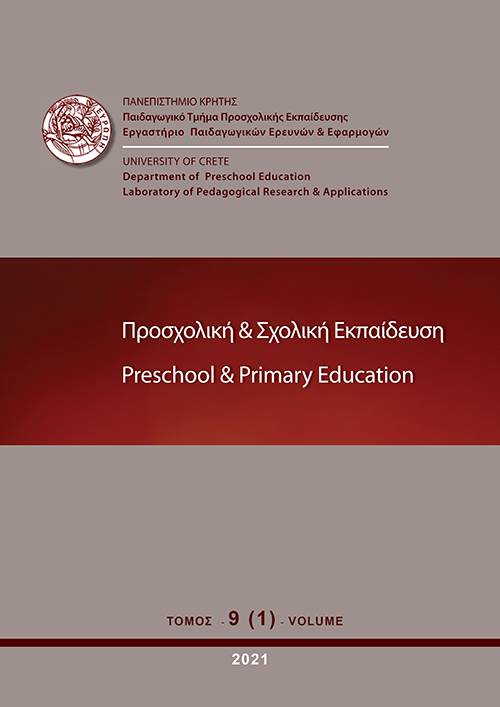Secondary special education teachers’ beliefs towards their teaching self-efficacy
Περίληψη
The self-efficacy of special education teachers is a key aspect of the educational process for inclusive learning and co-teaching. However, research on self-efficacy perceptions in the area of special education and particularly in the field of parallel support is very limited. The aim of this research is to adapt a scale measuring the beliefs of special education teachers’ self-efficacy in supporting students in need of parallel support in secondary education and therefore to investigate those beliefs as well as the factors that affect them. The study involved 147 special educators for supporting students in Greek junior high schools or high schools. To study and investigate the research questions, the “Teachers' Sense of Efficacy Scale” (TSES) of Tschannen-Moran & Woolfolk-Hoy (2001) was adapted. The results demonstrate that special education teachers report high levels of teaching self-efficacy with male special education teachers being distinguished by significantly higher self-efficacy levels, compared to females. Moreover, a positive correlation between the experience of participants and their levels of self-efficacy, a small negative correlation between the number of supported students and their levels of self-efficacy regarding teaching strategies as well as a medium negative correlation between the number of supported students and their levels of self-efficacy regarding student management, were revealed.
Λεπτομέρειες άρθρου
- Πώς να δημιουργήσετε Αναφορές
-
Mastrothanasis, K., Zervoudakis, K., & Xafakos, E. (2021). Secondary special education teachers’ beliefs towards their teaching self-efficacy. Preschool and Primary Education, 9(1), 28–51. https://doi.org/10.12681/ppej.24646
- Τεύχος
- Τόμ. 9 Αρ. 1 (2021)
- Ενότητα
- Άρθρα

Αυτή η εργασία είναι αδειοδοτημένη υπό το CC Αναφορά Δημιουργού – Μη Εμπορική Χρήση – Παρόμοια Διανομή 4.0.
Οι συγγραφείς των άρθρων που δημοσιεύονται στο ΠΡΟΣΧΟΛΙΚΗ & ΣΧΟΛΙΚΗ ΕΚΠΑΙΔΕΥΣΗ διατηρούν τα δικαιώματα πνευματικής ιδιοκτησίας επί των άρθρων τους, δίνοντας στο περιοδικό το δικαίωμα της πρώτης δημοσίευσης. Άρθρα που δημοσιεύονται στο ΠΡΟΣΧΟΛΙΚΗ & ΣΧΟΛΙΚΗ ΕΚΠΑΙΔΕΥΣΗ διατίθενται με άδεια Creative Commons 3.0 και σύμφωνα με την άδεια μπορούν να χρησιμοποιούνται ελεύθερα, με αναφορά στο/στη συγγραφέα και στην πρώτη δημοσίευση για μη κερδοσκοπικούς σκοπούς και με δικαίωμα τροποποίησης μόνον με παρόμοια διανομή (αν αναμείξετε, τροποποιήσετε, ή δημιουργήσετε πάνω στο υλικό, πρέπει να διανείμετε τις δικές σας συνεισφορές υπό την ίδια άδεια όπως και το πρωτότυπο). To Εργαστήριο Παιδαγωγικών Ερευνών και Εφαρμογών του Παιδαγωγικού Τμήματος Προσχολικής Εκπαίδευσης του Πανεπιστημίου Κρήτης και το Εθνικό Κέντρο Τεκμηρίωσης διατηρούν το δικαίωμα να δημοσιεύουν, να αναπαραγάγουν, να παρουσιάζουν στο κοινό, να διανέμουν και χρησιμοποιούν άρθρα που δημοσιεύονται στο ΠΡΟΣΧΟΛΙΚΗ & ΣΧΟΛΙΚΗ ΕΚΠΑΙΔΕΥΣΗ σε οποιοδήποτε μέσο και μορφή είτε μεμονωμένα είτε ως μέρη συλλογικών έργων, για όλο το χρόνο διάρκειας προστασίας της πνευματικής ιδιοκτησίας και για όλες τις χώρες του κόσμου. Αυτό περιλαμβάνει ενδεικτικά και όχι αποκλειστικά, το δικαίωμα δημοσίευσης των άρθρων σε τεύχη του περιοδικού ΠΡΟΣΧΟΛΙΚΗ & ΣΧΟΛΙΚΗ ΕΚΠΑΙΔΕΥΣΗ, αναπαραγωγής και διανομής μεμονωμένων αντιγράφων των άρθρων, αναπαραγωγής ολόκληρων των άρθρων σε άλλη έκδοση του Εργαστηρίου Παιδαγωγικών Ερευνών και Εφαρμογών του Παιδαγωγικού Τμήματος Προσχολικής Εκπαίδευσης του Πανεπιστημίου Κρήτης και του Εθνικού Κέντρου Τεκμηρίωσης και αναπαραγωγής και διανομής των άρθρων ή περίληψης αυτών με χρήση πληροφορικού συστήματος αποθετηρίου.



